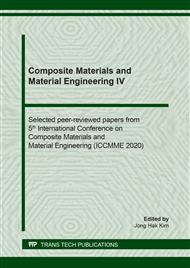p.114
p.120
p.129
p.135
p.141
p.149
p.155
p.161
p.167
Effects of the Usage of Wasted Diatomite and Phase Change Materials as Partial Replacement of Cement on the Mechanical Properties of Concrete
Abstract:
In this study, the wasted diatomite was added to the cement mortar after heat treatment, and the potential of replacing the silica fume to prepare high-strength concrete was discussed. In addition, the diatomite was used to adsorb the polyethylene glycol (PEG) to prepare a shape-stabilized phase change material (SSPCM). Moreover, the compressive strength of concrete and its performance as a temperature-regulating building material by the addition of SSPCM were investigated. The results show that the average compressive strength of the diatomite-containing test mortar after adding a water reducing agent reaches 505.27 kg/cm2, which meets the requirements of the compressive strength of the high-strength concrete. The thermal analysis results show that the diatomite successfully adsorbs PEG and the average compressive strength of SSPCM-containing test mortar reaches 235.42 kg/cm2, which meets the basic requirements of the compressive strength of concrete. The illuminating test shows that the internal temperature of the pristine cement test mortar is mostly higher than the surface temperature. However, the test mortar prepared by adding the SSPCM has a maximum reduction of internal temperature of 2.24 °C as compared with the surface temperature. It is shown that the diatomite which adsorbed phase change material can achieve the functions of lowering the internal temperature and adjusting the temperature of building materials.
Info:
Periodical:
Pages:
161-166
Citation:
Online since:
June 2020
Keywords:
Price:
Сopyright:
© 2020 Trans Tech Publications Ltd. All Rights Reserved
Share:
Citation:


